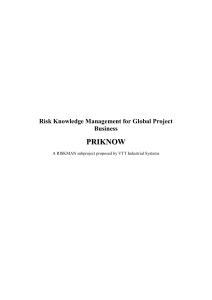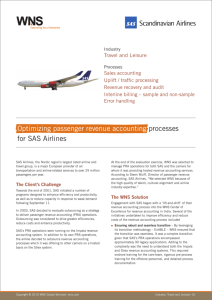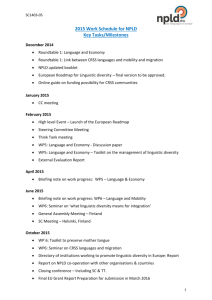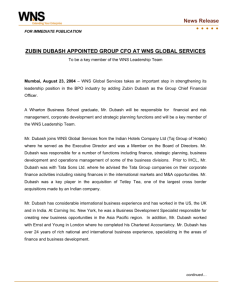Of Innovation
advertisement
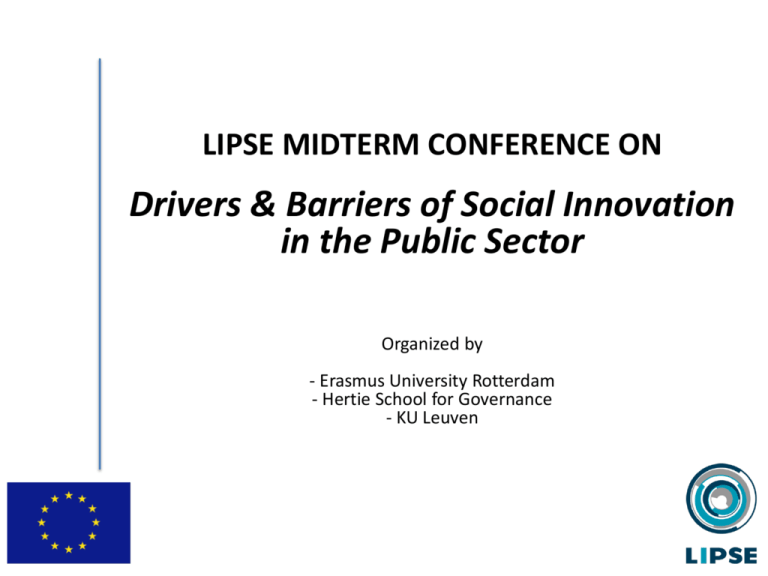
LIPSE MIDTERM CONFERENCE ON Drivers & Barriers of Social Innovation in the Public Sector Organized by - Erasmus University Rotterdam - Hertie School for Governance - KU Leuven Introduction by Victor Bekkers Introduction Prof. dr. Victor Bekkers Erasmus University Rotterdam www.lipse.org Twitter with us via @EULIPSE #LIPSE #Socialinnovation The social innovation challenge in the public sector • Merger of several developments that create a ‘policy window’ for change • Societal challenges as ‘wicked problems’ • Retreat of government and rediscovering the strengths of communities • Budget austerity • To produce need-oriented outcomes that really matter • Open process of co-creation with relevant stakeholders: collaborative innovation networks • Game-changer: fundamentally changes existing relations, positions and playing rules • Beyond technological innovations • Re-allocation of public values thereby reinventing publicness LIPSE To identify relevant drivers and barriers that explain the success or failure of social innovations in the public sector, and to give policy recommendations. To learn from cross-national and cross-sectoral comparisons to understand how social innovation practice convergence or diverge between states To advise policymakers and researchers on potential future pathways for social innovation in the public sector that can enhance productivity, growth and competitiveness in countries To contribute to the governance of social innovation in the public sector LIPSE Partners 1. 2. Erasmus University Rotterdam Ecole Nationale d'Administration 3. ESADE 4. Hertie School of Governance 5. KU Leuven 6. Luigi Bocconi Commercial University 7. Matej Bel University Banska Bystrica 8. National School of Political Studies and Public Administration 9. Radboud University Nijmegen 10. Roskilde University 11. Tallinn University of Technology 12. The University of Edinburgh The LIPSE Puzzle: themes and working packages Accountability, ombudman and audit Innovation capacity of innovation environments: leadership and trust Cocreation citizens Trends and scenarios: the future of social innovation Social innovation indicators Risk selection and risk govenance Dissemination of results Diffusion, adoption and upscaling Conference setup – Feb 3 11:00 – 11:10: Opening (Victor Bekkers) 11:10 – 11:20: Welcome by European Commission 11:20 – 11:50: Keynote: Where Innovation is Unavoidable (Christopher Pollitt) 11:50 – 12:05: Innovation capacity of innovation environments (Lykke Ricard) 12:05 – 12:30: Plenary discussion 12:30 – 13:30: Complimentary lunch 13:30 – 13:45: Risk-definition and risk governance in social innovation processes (Sophie Fleming) 13:45 – 14:00: Adoption, diffusion and upscaling of ICT-driven innovation (Maria Cucciniello) 14:00 – 14:15: Developing public sector innovation indicators (Rainer Kattel) 14:15 – 14:50: Plenary discussion 14:50 – 15:15: Coffee break 15:15 – 15:45: Interactive group discussions: Implications & poster presentation 15:45 – 16:00: Closing remarks 16:00 – 17:00: Reception Conference setup – Feb 4 9:00 – 10:00: Coffee 10:00 – 10:10: Opening (Victor Bekkers & Geert Bouckaert) 10:10 – 10:40: Keynote presentation by Gerhard Grill, director of the European Ombudsmen 10:40 – 11:05: The sustainability of social innovations: the possible role of auditors & ombudsmen (Geert Bouckaert) 11:05 – 11:30: Coffee break 11:30 – 12:15: Expert panel on social innovation: Mr. Weekers (Flemish Ombudsman), Mr. Put (Audit Manager, Belgian Court of Audit) & Mr. Daglio (OECD Observatory for Public Sector Innovation) 12:15 – 13:30: Complimentary lunch 13:30 – 14:00: Understanding co-creation with citizens during social innovation (Lars Tummers) 14:00 – 14:30: Plenary discussion: Implications for social innovation 14:30 – 15:00: Concluding remarks & farewell (Victor Bekkers) 15:00 – 16:00: Farewell & coffee Keynote: Where Innovation is Unavoidable by Christopher Pollitt INNOVATION AND LIPSE: AN INTERIM ASSESSMENT OF AN INNOVATIVE RESEARCH PROJECT Christopher Pollitt KU Leuven Public Governance Institute SPEECH TO LIPSE CONFERENCE: ROYAL FLEMISH ACADEMY OF BELGIUM, BRUSSELS, 3 FEBRUARY 2015 INNOVATION – A DANGEROUS CONCEPT • Conceptually unstable • Normatively loaded 1. Always a good thing 2. The career of the concept 3. Innovation-centricity LIPSE – THE PROMISE • Aware of normative dimension • Treats innovation as embedded/contextualized • Comparative (states and sectors) LIPSE – THE ANXIETIES • • • • Failed innovations? Transcending case studies – representativeness? Temporal dimension? Evaluation of innovations? CONCLUSIONS • LIPSE – once-in-a-decade opportunity • Doing better than well A CLOSING THOUGHT FOR PUBLIC SECTOR INNOVATORS – AND FOR LIPSE RESEARCHERS ’He that will not apply new remedies must expect new evils, for time is the greatest innovator’ (Francis Bacon, English philosopher, lawyer, essayist, courtier, in his essay Of Innovation 1625) Work Package 1: Innovation capacity of innovation environments by Lykke Ricard Innovation environment and innovation capacity in the public sector (LIPSE: WP1) • Dr. Lykke Margot Ricard, Roskilde Universitet lykker@ruc.dk & • Professor Jenny M. Lewis, University of Melbourne jmlewis@unimelb.edu.au 4 Nations/municipalities in the study Nation/municipality Strength of local government (rank amongst these) Innovation Union score 2013 (rank amongst these) a Innovation City score 2014 -rank in the world (amongst these) b DK/ Copenhagen 2 .728 (1) 9 (1) ES/ Barcelona 1 .414 (4) 56 (2) NL/ Rotterdam 2 .629 (2) 66 (3) UK/ Edinburgh c 3 .613 (3) 71 (4) a. Measure of strength of national economy b. Measure of cultural assets, human infrastructure, and networked markets c. Proxy for Scotland/ West Lothian Data gathering Several methods were used to gather information on the innovation capacity of these environments. These were: • Document analysis of the organizational structure of the municipalities • Survey of administrators and politicians in each of the municipalities, administered as an online survey in all except West Lothian (paper-based). 175 responses to the survey were received for Copenhagen (173 administrators and 2 politicians); 171 responses were received for Rotterdam (162 administrators and 9 politicians); 73 for Barcelona (66 administrators and 7 politicians); and 52 for West Lothian (all administrators) • Interviews with community-based innovators were conducted with individuals who had been nominated through the survey. City Main current and future Innovations Drivers socioeconomic challenges (5 most nominated) (5 most nominated) 1.Financial (cuts) 1. organization development (trust 1 municipal election 2.Demography (growth in size, based management i.e. getting rid of campaigns aging population) time-taking 2. the municipality statutory committee 3.environmental( infrastructure, 2. citizen outreach (empowerment, meetings pollution, securing green areas) involving citizens ) 3. the municipality advisory committee 4. political (inclusion business, 3. IT and organizational development meetings citizens, users etc.) (Digitalization) 4. the business elite of the city 5. social equity (poverty, and social 4. new service (after hours etc.) 5. pay and promotion system isolation) 5. new services (empowering weak (5 most nominated) Copenhagen citizens , i.e . rehabilitation of elderly) Rotterdam 1.unemployment/poverty 1.Digital public service (incl. use of social 1.Contact with and involvement of citizens 2.education attainment/youth media) (mismatch, school dropout) 2.uniform digital management (internal) 2.the current economic crisis 3.diversity/segregation 3. citizen engagement and consultation and community groups 3.the business elite of the city (multiculturalism, social segregation 4. collaborative governance (new role 4.media attention 4.physical environment (housing, for government) 5.National government pressure on pollution etc.) 5. organization of public health care municipalities 1.assistance to vulnerable persons 1.new services (sustainable public 1.quality of proposals coming from local 2.unemployment procurement, payment within 30 days) politicians 3.exemplary management of public 2.new service (bus network,) 2.municipal election campaigns administrations 3. new services (smart city) 3.pay and promotion system 4.economic revitalization 4.organization (co-responsibility tables) 4.values and culture of executive 5.consolidation of the Barcelona 5. recognition (international events) management (not politicians) 5. organization of health care (decentralization, budget cuts) Barcelona brand Table 1: Socioeconomic challenges, innovations and drivers of innovation 5.contact with and involvement of citizens and community groups Innovation context: challenges, innovations, drivers Concluding that: 1) There are striking similarities in the socioeconomic challenges that are mentioned for each city (demographic changes, economic growth, unemployment, health care and educational problems), but the types of innovations and drivers are contextually determined. Recommending that different municipalities will need to encourage innovation at the point where it is able to have the greatest impact. In one municipality this might mean focusing on politicians and the political system, while in another it might mean focusing on internal structures and procedures and in yet another, innovation is likely to be externally driven. Innovativeness measures Ranking (out of Copenhagen Rotterdam Barcelona these 4) Innovation West Lothian city 1 4 2 3 3 4 2 1 1 3 2 N/A 1 3 4 2 index* Self-rated innovativeness Innovativeness (community rated) Innovation drivers Table 2: Rank order of municipalities on innovation measures * Edinburgh used as a proxy for West Lothian Concluding that 2) A a good way to gauge a municipality’s innovativeness might be to assess the drivers and barriers to innovation, based on its procedures and structures and local contextual factors, rather than using internal perceptions of innovativeness. Networking activities 40 35 30 25 20 15 10 5 0 Copenhagen Rotterdam Barcelona West Lothian Concluding 3) The amount and type of external communication is also context dependent and linked to selfrated innovativeness, suggesting that municipalities with a stronger external focus see themselves as more innovative (perhaps because of this focus). Concluding 4) Boundary spanning follows a similar pattern to external communication, suggesting that municipalities that do more of this see themselves as more innovative (perhaps because of this). 40 35 30 25 20 15 10 5 0 Copenhagen Rotterdam Barcelona West Lothian Who do you go to: Work and strategic information networks Formal hierarchical structures tend to be slow in sensing changes in the environment, whereas informal networks are more dynamic and so, are crucial for innovation. In each of the municipalities, the informal networks are shaped by the formal organizational structure. Who do you go to: Work and strategic information networks Concluding that: 5) In order to increase innovation capacity, the organizational structure should be the focus, because getting the right structure shapes the informal networks which are crucial to innovation and its operational efficiency. 6) The informal structure needs to support the creation and use of both strong and weak (or bonding and bridging) ties, so that there is enough internal support from peers, and enough openness to gain new information from different actors within and outside the organization, to support innovation. 7) Increasing the innovative capacity of any municipality will depend on gaining the support of the ‘go to’ people. They might be politicians in some cases, directors in others, and managers or other individuals in other cases. Network brokers Brokers play an important function in innovation through their capacity to act effectively because of the diverse sources of information they can draw upon. The brokers in the strategic information networks tend to be at different levels in differen municipalities. Two types of brokers were observed – one with an entrepreneurial structure of ties (diversity) and one with ties that are linked to each other (closure), This is shown for Copenhagen in figure 2. Person 170 has diverse ties while person 25 has ties that are linked to each other (closure). Three main conclusions Structure & internal environments Public sector organizations need some degree of rule-following, hierarchy and agreed procedures. Municipalities that are better able to provide a safe environment for risk-taking and motivating others will do better in terms of social innovation. This likely translates into less emphasis on hierarchical control and more freedom for individuals and groups to initiate ideas. Network & external environments Involving the community in both defining socioeconomic challenges and aligning innovations with these should prove beneficial. The amount of overlap between the inside and outside view suggests at least some degree of agreement in each municipality, while the differences highlight the possible additional richness to be gained from an outside perspective. Leadership Leadership styles are more ‘social’ than the classical entrepreneurial leadership styles in the private sector and they are also more related to organizational motivational factors and network governance qualities The LIPSE project’s work package 1 (WP1) study provides, an important advance in linking innovation environments to innovation capacity in the public sector (specifically, municipalities). Additional research will progress this even further and generate much needed information on how to increase social innovation capacity. The report and policy brief can be downloaded via www.LIPSE.org Thank you Work Package 4: Risk-definition and risk governance in social innovation processes by Sophie Flemig WP4: Risk Definition and Risk Governance in Social Innovation Processes A comparative case-study across four countries LIPSE Midterm conference Presented by Sophie Flemig Developed with Stephen Osborne, Tony Kinder, Juraj Nemec, Beata Mikusova, Valentina Mele, Taco Brandsen and Marieke van Genugten WP4 Research Goals • To identify the current range of approaches to risk in innovation in public services across European countries as well as to identify the key contingencies in two policy sectors. • To empirically identify and evaluate current approaches for relevant stakeholders to engage in discussions about levels of risk for public service innovations and how these discussions are translated into specific risk management and governance models. • To make recommendations regarding the formulation of relevant principles for effective risk governance in innovation in public services. • To disseminate the results and policy recommendations among relevant policy makers and within the public management community WP4 Research Question and Participants • How does the definition and governance of risk influence social innovation? • 4 country study: Italy, Netherlands, Slovakia, UK • 2 fields: mental health and sustainable public services WP4 Methodology • Document Analysis – Websites – Internal communications – Risk management tools • Survey Analysis • 200 contacts per country, 717 responses in total • Case Study Analysis • 4 case studies per country: 2 on mental health, 2 on sustainable public services • 6-8 interviews per case study • Total of 16 case studies and 96-128 interviews WP4 Conceptual Framework WP4 Survey Findings: Cross-National • Respondents showed difficulty in conceptualising risk • Managerial staff more aware of “risk management” • Risk management strategies still in place, described as “everyday activities” • Very few dedicated risk managers • Connection between risk and innovation affirmed but most often not incorporated in work and planning processes • In relation to innovation capacity, most often referred to … • Sustainability • Financial risks • Reputational risks • Regulatory/bureaucratic risks • Mental Health • Health and safety risks (service users) • Financial risks • More hard risk management in mental health, more soft tools in sustainability • Accounted for by top-down regulatory system in mental health • • • • • • WP4 Survey Findings: National Differences Italy “all roads lead to lack of participation of the local community” • Engagement of local community as proactive risk management Mostly non-profit organisations • Difference in risk management for innovations between associations and cooperatives Netherlands Innovation mostly bottom-up in sustainability, top-down in mental health Few formal risk management strategies (new, small organisations in sustainability, more surprising in larger, established mental health organisations) • Slovakia • Strong public sector presence in both mental health and sustainability • Explicitly acknowledged PPPs as ambivalent (more risk than source of innovation, esp. partnerships with local government) • UK • • Decentralised risk management standards, esp. in mental health (informal sharing) Regulatory/bureaucratic risk management seen as stifling innovation in environmental sustainability WP4 Emerging Case Study Findings • Interviews just completed (by 31st January 2015) -> emerging results only • Confirmed that financial risks most important overall • Service user risk for mental health • Reputational risk for sustainability • Top-down risk management approaches, esp. in mental health, implementation driven by local stakeholders • Institutionally-driven risk management in sustainability • Driven by funding calls • Often minimise risk as part of funding contract • Innovation still precondition for new funding • Resulting tension leads many organisations to become more risk averse when it comes to innovation that is task/service driven WP4 Emerging Implications Policy • Recognising the role of regulation and institutional frameworks rather than an understanding of innovation processes as driver for risk management • Move away from minimisation of risk if policy is meant to encourage innovation • Encourage/provide follow-up funding to make innovations sustainable (funding risk paramount!) Practice • Acknowledge effects of risk management on innovation in funding calls (i.e. level of detail) • Raise awareness and acknowledge risk as core of the process of innovation • • Make connection explicit within organisation Differentiate types of risk and adjust hard/soft risk management approaches accordingly Work Package 5: Adoption, diffusion and upscaling of ICTdriven innovation by Maria Cucciniello LIPSE – “Learning from Innovation in Public Sector Environments” Mid term conference First Findings and Policy Recommendations of LIPSE WorkPackage 5 “Adoption, Diffusion and Upscaling of ICT-driven Social Innovations” Prof. Maria Cucciniello, Ph.D. Assistant Professor Department of Policy Analysis and Public Management Bocconi University Brussels, Royal Flemish Academy of Belgium for Science and the Arts February 3rd – 4th, 2015 Agenda WP5 Objectives WP5 Timeline WP5 Theoretical Framework Scope of WP5 Empirical Analysis WP5 Qualitative Analysis Schedule of Activities in Progress WP5 Key Researchers WP5 Objectives Which focuses of analysis? To theoretically and empirically identify the drivers and barriers that play a role in the upscaling of ICT driven innovations, in relation to the specific characteristics of followers, late adopters and laggards; To develop policy guidelines and instruments that public decision-makers can use to improve adoption, diffusion and upscaling of ICT driven innovations; To disseminate the research results and policy recommendations. ICT-driven social innovation Types of adopter that intervene in late stages of the innovation lifecycle (i.e. followers, late adopters, laggards) The stage of upscaling Two ICT driven innovation (e-procurement and telework) Six European countries that differ in terms of ICT readiness (France, Italy, the Netherlands, Romania, Slovakia, Spain) WP5 Timeline Achievements and next steps JAN. 2014 Launch of the WP FEBR. 2014 Submission of the PID Deliverable 5.1 JULY 2014 WP5 Qualitative Analysis Protocol SEPT. 2014 WP5 Theoretical Framework JAN. 2015 WP5 Working Paper Presented at EGPA 2014 Released FEBR. 2015 WP5 Empirical Analyses APRIL 2015 WP5 Research Report Deliverable 5.2 MAY 2015 WP5 Policy Brief and Presentation of Main Findings Deliverables 5.3 & 5.4 WP5 Theoretical Framework “Determinants and Barriers of Adoption, Diffusion and Upscaling of ICT-driven Social Innovation in the Public Sector: A Systematic Review” Sources LIPSE systematic literature review; EU social innovation projects (e.g. LIPSE, TEPSIE, COCOPS, WILCO); PA journals E-Government journals; Management journals; Public procurement journals; Organizational studies journals; Books. Use of a methodology similar to WP2 Applicable filters Public sector; Determinants; Barriers; Adoption; Diffusion; Upscaling; Level of government. Study of determinants and barriers as a common objective of WP1, WP2, WP3 and WP4 Steams of research (Social) Innovation; ICT-driven innovation (in the public sector); E-Government; E-Procurement; Telework. 454 records [6 on upscaling] 194 final records [3 on upscaling] Records excluded WP5 Timeline Structure Clustering of determinants and barriers on the basis of: STAGE OF THE INNOVATION CYCLE TYPES OF ADOPTER (i.e. pioneers, followers, late adopters, laggards) (i.e. adoption, diffusion, upscaling) TYPOLOGY OF INNOVATION (focus on e-procurement and telework) Unpacking of determinants and barriers on three levels: 1 INNER vs. OUTER CONTEXTS 2 DIMENSIONS WITHIN THE CONTEXTS 3 SPECIFIC DETERMINANTS AND BARRIES WP5 Timeline Findings Upscaling is strongly driven by isomorphism of later adopters Legal constraints can be a great barrier to upscale eprocurement Early adopters are set in richer and greater geographical contexts ICT infrastructures (e.g. broadband) are crucial drivers of telework adoption OUTER CONTEXT INNER CONTEXT Inter-institutional dynamics (Isomorphism – Mimicking – Competition) Legal factors (Legislative imposition – Law clarity – Law complexity) Organizational factors (Slack resources – Organizational size – Managerial leadership and political support – Risk-averse culture) Political factors (Political cycle – Form of government – Autonomy) Economic factors (Economic wealth – Employment – Fiscal capacity – Budget constraints) Social factors (Education and cultural wellbeing – Stakeholders’ attitude – Public opinion and pressures) Demographic factors (Population size – Population density) Technological factors (ICT infrastructures – Citizens’ ICT readiness) Individual factors (Individual perceptions – Managers’ personal characteristics – Professionalism of public personnel – Employees’ ICT readiness – Employees ICT acceptance) Technological factors (Innovation’s complexity – Innovation’s security and reliability – Organizational ICT readiness) Cultural inertia strongly hinder adoption, diffusion and upscaling of most innovations Early adopters are usually involved in PPPs The upscaling of e-procurement is hindered by individual skepticism and ICT scarce readiness Scope of WP5 Empirical Analyses Identification of determinants and barriers that play a role in the implementation and upscaling of ICT-driven innovation, in relation to the specific characteristics of followers, late adopters and laggards Two policy fields E-PROCUREMENT and TELEWORK Six countries FRANCE, ITALY, NETHERLANDS, ROMANIA, SLOVAKIA, SPAIN WP5 QUALITATIVE ANALYSIS WP5 QUANTITATIVE ANALYSIS WP5 Qualitative Analysis Process 2 CASES E-PROCUREMENT TELEWORK Per each country, one agency at the regional level that has adopted and upscaled e-procurement Per each country, one agency that has been exposed to telework * * The analysis has shown how not all the countries present analyzable cases at the local level. The EU has consented to change the focus at the regional or national level when needed. Works have been slightly protracted by this contingency. Five in-depth, semi-structured interviews with key internal stakeholders [5 interviews * 2 innovations * 6 countries = 60 interviews in total] ANALYSIS OF THE INTERVIEWS CROSS-COUNTRY COMPARISON SURVEY OF THE QUANTITATIVE ANALYSIS WP5 Qualitative Analysis First empirical findings on e-procurement OVERALL EVALUATION OF FINDINGS FROM THE SIX CASES ANALYZED Outer Context Inner Context Inter-institutional ✓ Legal ✓ Political ✓ Social = Economic ✓ Demographic ✓ Technological ✓ Organizational = Individual ✓ Technological ✓ * A portion of the findings are preliminary WP5 Qualitative Analysis First empirical elements on telework CASES ANALYZED IN EACH COUNTRY France Italy Netherlands Romania Slovakia Spain Paris’ department Autonomous Province of Trento Municipality of Krimpen aan den IJssel Cases virtually absent and no regulation – Further scouting in progress Slovak National Library Autonomous Government of Catalonia (Local) (Local) (Local) (National) (Regional) Most experiences are implemented on a limited basis and/or very peculiar in nature (“fit-for-purpose”); Severe difficulties in identifying telework cases in the public sector; PRELIMINARY FINDINGS ON DETERMINANTS AND BARRIERS Positive Negative Outer context Social cohesion, governmental autonomy and budget constraints Labor regulations Inner context “Bottom-up” entrepreneurial attitude and internal ICT facilities Risk-averse culture WP5 Schedule of Activities in Progress Aug ‘14 Sep ‘14 Oct ‘14 Nov ‘14 Dec ‘14 Jan ‘15 Feb ‘15 Mar ‘15 Apr ‘15 May ‘15 Execution of qualitative analysis Development of crosscountry comparison Quantitative and statistical analysis Development of research report A Development of policy guidelines and recommendations B Presentation of main findings C A Deliverable 5.2 “Research Report” B Deliverable 5.3 “Policy Brief” C Deliverable 5.4 “Presentation of Main Findings” WP5 Key Researchers Institution CERGAS, Bocconi University Department of Public Administration, Erasmus University Rotterdam Ecole Nationale d’Administration Institute for Public Governance and Management of Ramon Llull University ESADE The Faculty of Public Administration, National School of Political Studies and Public Administration The Faculty of Economics, Matej Bel University Country Key researchers working on WP5 Italy Greta Nasi (WP leader) Maria Cucciniello Valentina Mele Giovanni Valotti Raffaele Bazurli The Netherlands Hanna de Vries Victor Bekkers Lars Tummers France Michel Eymeri-Douzans Erwane Morette Monthubert Vanessa de Froidcourt Spain Mila Gascó Tamyko Ysa Charlotte Fernández Adrià Albareda Romania Ani Matei Carmen Savulescu Catalina Antonie Elis Bianca Balaceanu Slovakia Nemec Juraj Mária Svidroňová Beata Mikusova Merickova Marta Oviska Thank you

